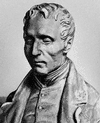Huruf Braille adalah suatu sistem penulisan yang menggunakan titik-titik yang timbul yang mewakili karakter tertentu. Huruf yang diciptakan oleh louis braille ini pada awalnya diperuntukkan untuk orang tuna netra. Namun kini berkembang hingga kedunia detective sebagai kode-kode untuk menyamarkan sebuah makna tertentu. Huruf braille kini sudah berkembang luas ke seluruh dunia dan membantu banyak orang yang memiliki penglihatan yang kabur hingga buta total.
Braille terdiri dari sel yang mempunyai 6 titik timbul dan kehadiran atau ketiadaan titik itu akan memberi kode untuk simbol tersebut. Huruf Braille Bahasa Melayu adalah hampir sama dengan kode huruf Braille Inggeris. Perkataan, simbol (seperti tanda seru dan tanda soal), beberapa perkataan dan suku kata bisa didapat secara terus. Contohnya perkataan orang disingkat menjadi org. Ini membolehkan buku Braille yang lebih tipis dicetak.Huruf Braille juga telah diperkaya sehingga dapat digunakan untuk membaca nota musik dan matematik.
Kini Braille telah diubahsuai dengan menambah dua lagi titik menjadikan Braille menjadi kode 8 titik. Ini memudahkan pembaca Braille mengetahui huruf tersebut adalah huruf besar atau kecil. Selain itu, penukaran ini membolehkan huruf huruf ASCII dipertunjukkan dan kombinasi 8 titik ini diekodkan dalam standard Unicode. Braille boleh dihasilkan menggunakan batuan loh (slate) dan stilus ( stylus ) di mana titik dihasilkan daripada belakang muka kertas, menulis dengan gambar cermin, menggunakan tangan, atau menggunakan mesin taip Braille yang dikenali sebagai Perkins Brailler. Braille juga dapat dihasilkan menggunakan mesin cetak Braille yang disambung kepada komputer.
Braille Alphabet and Braille Code
Braille code is a writing system which enables blind and partially sighted people to read and write through touch. The braille alphabet was invented by Louis Braille (1809-1852), a French teacher of the blind. It consists of patterns of raised dots arranged in cells of up to six dots in a 3 x 2 configuration. Each cell represents a braille letter, numeral or punctuation mark. Some frequently used words and letter combinations also have their own single cell patterns.
There are a number of different versions of braille code:
- Grade 1: consists of the 26 standard letters of the alphabet and punctuation. It's mainly used by people who just started reading braille.
- Grade 2: consists of the 26 standard letters of the alphabet, punctuation and contractions. The contractions are employed to save space because a braille page cannot fit as much text as a standard printed page. Books, signs in public places, menus, and most other braille materials are written in Grade 2 braille.
- Grade 3: is used only in personal letters, diaries, and notes. It is a kind of shorthand, with entire words shortened to a few letters.
Braille has been adapted to write many different languages and is also used for musical and mathematical notation. Contact Braille Works today to learn how we can help with all of your braille and alternative format needs.
Braille Letters



Now for the great man who made it all possible
(born January. 4, 1809, Coupvray,
near Paris, died. January. 6, 1852, Paris),
Braille was himself blinded at the age of three in an accident that occurred while he was playing with tools in his father's harness shop. An awl slipped and plunged into his eye. Sympathetic ophthalmia and blindness followed. Nevertheless, he became an excellent organist and cellist. Upon receiving a scholarship, he went in 1819 to Paris to attend the Institution Nationale des Jeunes Aveugles (National Institute for Blind Children), and from 1826 he taught there.
When Louis Braille entered the school for the blind inParis, in 1819, he learned of a system of tangible writing using dots, invented in 1819 by Captain Charles Barbier, a French army officer. It was called night writing and was intended for night-time battlefield communications. In 1824, when he was only 15 years old, Braille developed a six-dot "cell" system. He used Barbier's system as a starting point and cut its 12-dot configuration in half. The system was first published in 1829 a more complete elaboration appeared in 1837.
Braille's system was immediately accepted and used by his fellow students, but wider acceptance was slow in coming. The system was not officially adopted by the school in Paris until 1854, two years after Braille's death. A universal Braille code for the English-speaking world was not adopted until 1932, when representatives from agencies for the blind in Great Britain and the United States met in London and agreed upon a system known as Standard English Braille, grade 2. In 1957 Anglo-American experts again met in London to further improve the system.
For the last years of his life Braille was ill with tuberculosis. His remains, returned to his birthplace after his death, were in 1952 sent to Paris, to be buried in the Panthéon.










.jpg)
.jpg)

.jpg)





0 comments:
Post a Comment
Note: Only a member of this blog may post a comment.